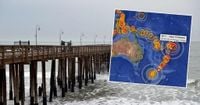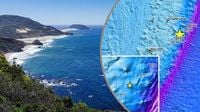A strong earthquake struck the Kingdom of Tonga in Oceania on Sunday, March 30, 2025, registering a magnitude of 7.1. The tremors were recorded by the US Geological Survey (USGS), which also issued a warning about the potential for tsunami waves within a 300-kilometer radius of the epicenter.
The earthquake occurred at a depth of 16 kilometers, as reported by the German Research Center for Geosciences (GFZ). According to the European Seismological Center (EMSC), the shocks were felt 94 kilometers southwest of the city of Pangai on Lifuka Island, part of the Tonga archipelago.
In its alert, the USGS warned residents to be prepared for the possibility of dangerous tsunami waves along the coast of Tonga. "Dangerous tsunami waves may occur within 300 km of the epicenter of this earthquake," the agency stated, urging locals to follow directives from national authorities.
Fortunately, as of now, there have been no reports of injuries or fatalities linked to the earthquake. However, the situation remains fluid as the threat of a tsunami looms. The National Emergency Management Office of Tonga has advised residents, particularly those in low-lying coastal areas, to move to higher ground or further inland to avoid any potential dangers.
This earthquake in Tonga follows a devastating earthquake that occurred just two days prior in Myanmar, where a magnitude 7.7 quake resulted in at least 1,700 deaths and over 3,000 injuries. The tremors from that earthquake were felt in neighboring countries, including Thailand, China, and India, with Thailand reporting at least 17 fatalities and 32 injuries.
Tonga is situated in the Pacific, between New Zealand and Hawaii, and is part of the so-called Pacific Ring of Fire, an area known for its high seismic activity and frequent earthquakes. The islands consist of more than 170 islands, many of which are inhabited.
In the aftermath of the earthquake, social media platforms have been flooded with videos showing residents fleeing from beaches and coastal areas as sirens sounded, signaling the potential danger of tsunami waves. The alert from the USGS and local authorities has heightened concerns among the population, who are accustomed to living in a seismically active region.
Historically, Tonga has experienced numerous earthquakes, and its geographic location makes it particularly vulnerable to seismic events and volcanic activity. The region's tectonic plates are constantly shifting, leading to both earthquakes and volcanic eruptions.
As authorities continue to monitor the situation, they are also assessing the structural integrity of buildings and infrastructure in the affected areas to ensure the safety of residents. Emergency services are on high alert, ready to respond to any incidents that may arise as a result of the earthquake or potential tsunami.
In light of this recent seismic activity, experts are reminding residents of the importance of preparedness in the face of natural disasters. Having an emergency plan in place, knowing evacuation routes, and being aware of the nearest high ground can be crucial for survival during events like this.
The international community is also keeping a watchful eye on the situation in Tonga. As reports of the earthquake spread, various organizations and governments have expressed their willingness to provide assistance if needed. Humanitarian aid may be necessary, depending on the impact of the earthquake and any subsequent tsunami.
In summary, the earthquake in Tonga serves as a stark reminder of the geological forces at play in the Pacific region. As residents remain vigilant and authorities work to ensure public safety, the hope is that the people of Tonga will remain safe from the expected tsunami and any aftershocks that may occur in the coming days.
As the situation develops, updates will be provided by local news outlets and international agencies monitoring the seismic activity in the region. The people of Tonga are resilient, and their ability to adapt to the challenges posed by their environment continues to be tested.








